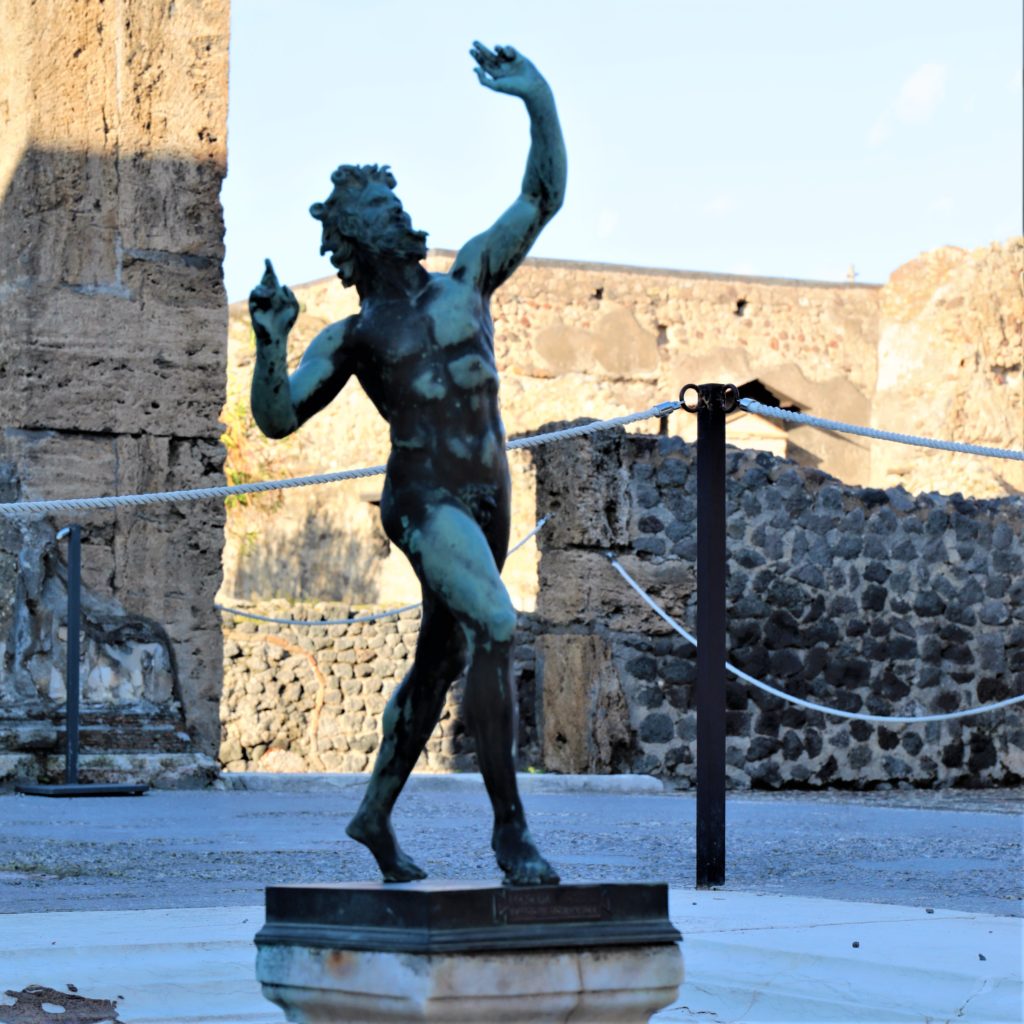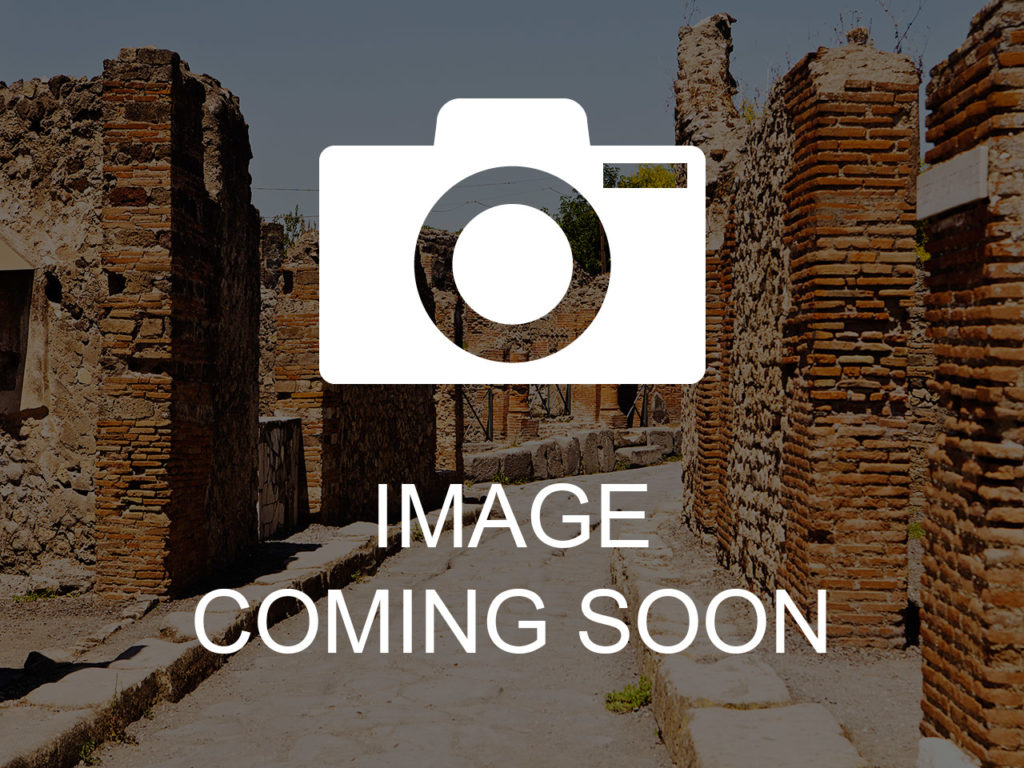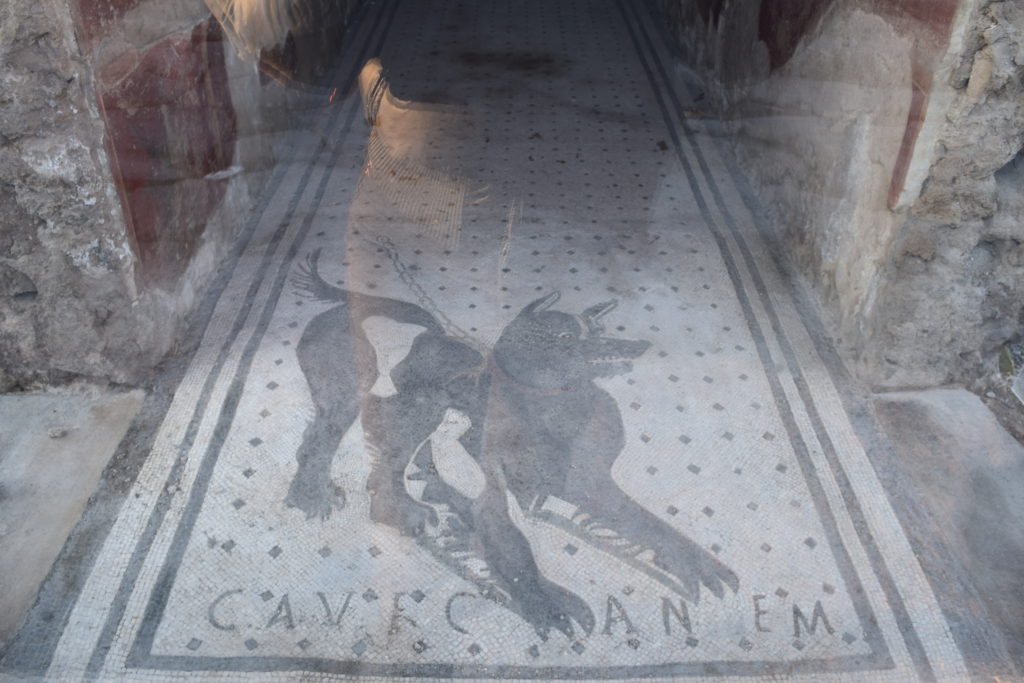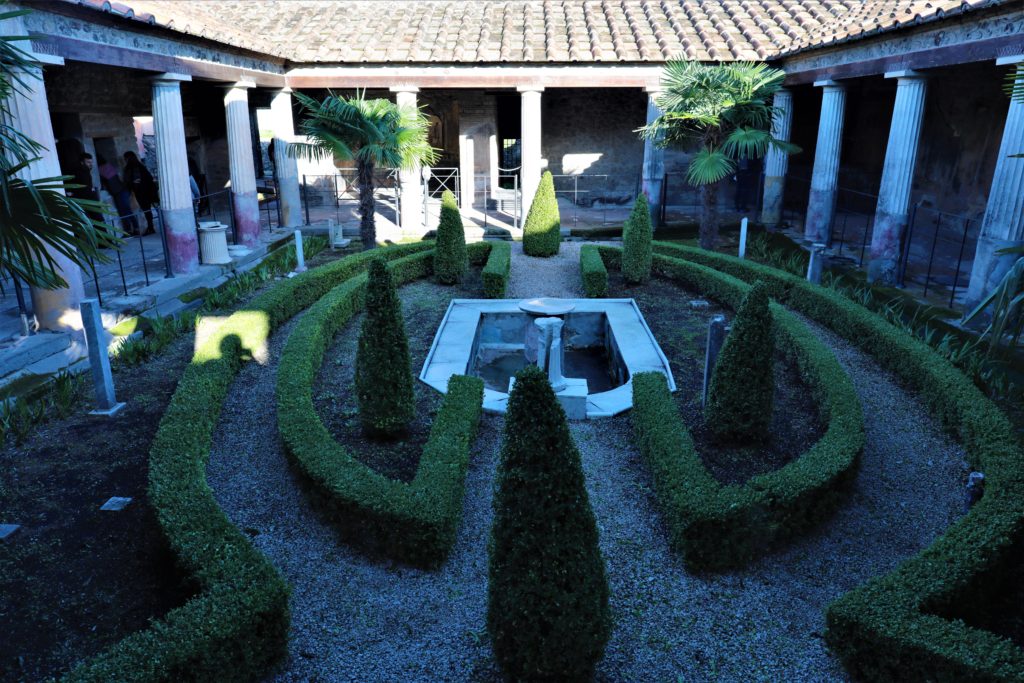Map
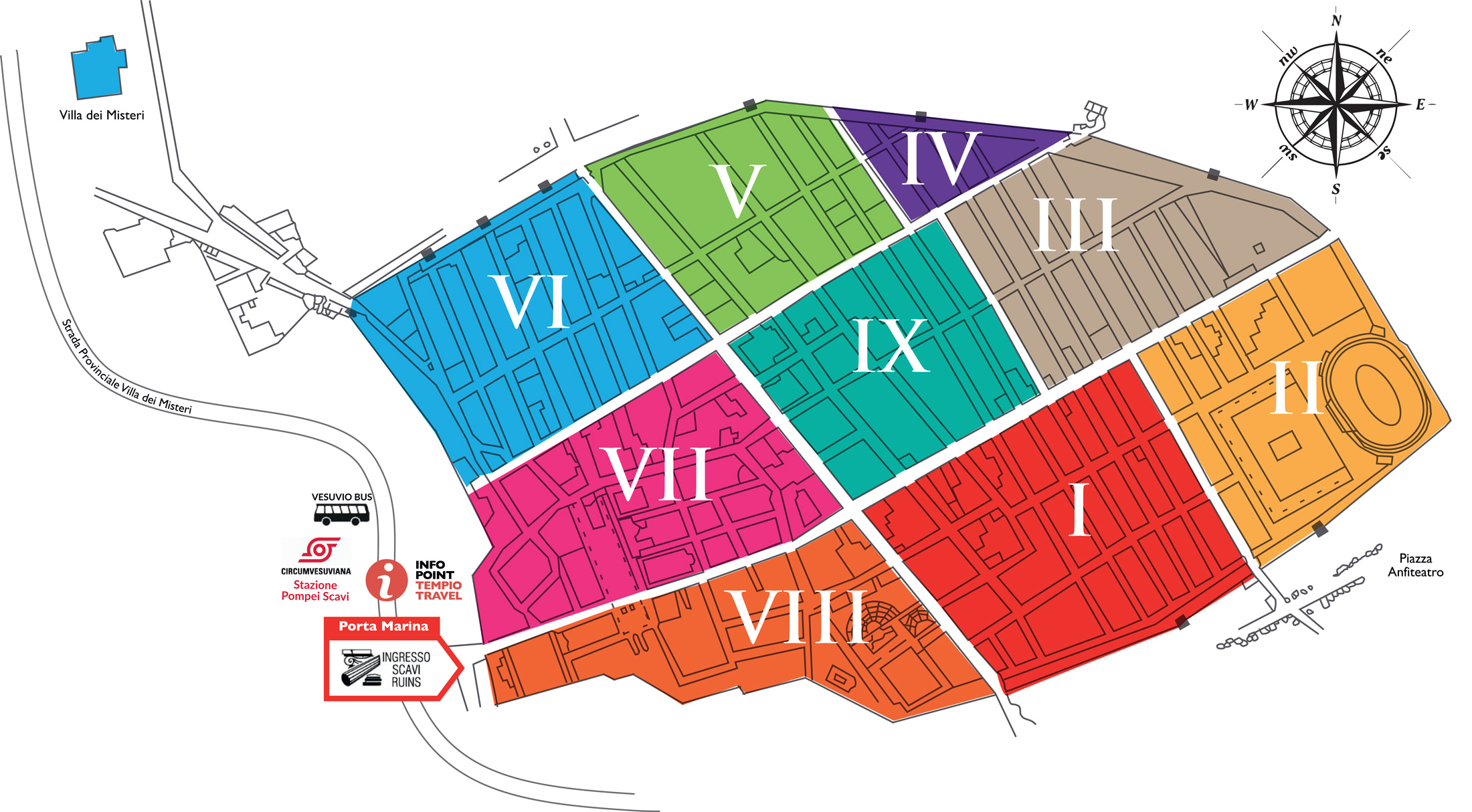
REGIO VII
REGIO I
REGIO II
REGIO III
REGIO IV
REGIO V
REGIO VI
REGIO VIII
REGIO IX
REGIO VI
House of theFaun
The House of the Faun isnamed after the statue of a dancing faunfoundthere.Itoccupies an entire insula and wasbuilt over an earlier 3rd century BC dwellingwhich, with itshortus, was on the site of whatisnow the first peristyle. The housewasdiscovered and excavatedaround 1830.In front of the mainentranceis the word HAVE, meaningwelcome.A small vestibuleopensinto the fauces whichhas a richlydecoratedfloorconsisting on small triangularpieces of coloured marble and slate.In the second part of the house is the mostfamous of ancientmosaic pictures, the battlebetween Alexander and Darius. The mosaicis a reproduction of a painting made either in the lifetime of Alexander
House of the Anchor
The house isnamed after the anchor depicted in the mosaicat the entrance, whichrepresents a symbol of peace and safety. The second partof the house hastwolevels: the upperlevel is centredaround a large terrace and the lowerlevelistaken up by a garden.Thereis a large aedicula in the portico and an altar.Date of excavation: 1826-1827; 1828-1829.
House Of The Small Fountain
The House of the Small Fountainislocated on the Via di Mercurio. The propertywas first excavated in 1823 and again in 1826.This house derivesits name from a mosaicfountainat the rear of the peristyle.The atrium haslostmost of its fresco decoration.The flooris dark gray with small white marble chips. On the east side of the atrium is the tablinum . The floor of the tablinum has a broad decorative border in black and white mosaic.
The peristyle iscolonnaded on two sides. On the rearwall of the peristyle is the ‘small’ fountain. The use of the fountain-nymphaeum, generallycovered with mosaics and decorated with sculptures, becamefairlywidespread by the middle of the 1st century AD.
House Of The Tragic Poet
The House of the TragicPoet, excavated in 1824, liesat the corner of the Via delle Terme and the Via della Fullonica.The house has the classic layout of a Samnite House. The fauces has a black and white mosaicfloor featuring the wellknownmosaic of a dog on a chain bearing the warning cave canem, ‘beware of the dog’. At the north end of the impluvium is a marble puteal used for drawing water from the cisternbeneath. The atriumwasrichlydecorated with six large frescoesdepictingscenes from the Illiad. The tablinum has a fine black and white mosaicfloor with a geometricmotif.
House of Pansa
The House of Pansa occupies an entire city block. The house wasinitiallyexcavated in 1810 and again in 1813, 1827, 1852 and finally in 1943 after the propertywasbombed. The fauces opensdirectlyonto a large Tuscan style atrium with a central impluvium. In the middle of the peristyle is a small garden with a basinoriginallydecorated with images of water plants and fish on a blue ground.The peristyle hadsixteen Ionic columnssupporting the innermargins of the roof he basinfeatured a small fountain in its centre.
House of Vettii
This house, excavated in 1894-95, derivesits name from twobronzesealsfoundnear a strongbox in the atrium. The seals bore the names of twofreedmenbrothers, AulusVettiusRestitutus and AulusVettius Conviva. Like severalother notablehouses in Pompeii, the house was a casualty of bombingduring the second World War. The moststriking feature on entering the fauces is the fresco, to the right of the door, of Priapus, god of fertility and abundance, probablythere to ward off the evileye of thoseenvious of the owners’ wealth and circumstanceThe fauces opensonto the atrium (b) whichhas a marblelined impluvium in its centre. The atrium iswithout a tablinum; on its west side itopensdirectlyonto the peristyle and garden.
House of the Golden Cupids
This house, initiallyexcavatedbetween 1903 and 1905, isthought to have once belonged to GnaeusPoppaeus Habitus. Itwasnamed after the glass discs etched with cupidsfound in a cubiculum off the peristyle. The fauces leads to a square atrium with a central impluvium. The atrium isnow in a poorcondition, but, from whatremains, the third style decorationoriginallyappears to haveconsisted of red panels featuring figuredlandscapesseparated by black bands.
On the west side of the atrium is the tablinum (e) whichisalsodecorated in the third style. The tablinum has a fine white mosaicfloor with a narrow double border in black and a central decorative panel with a geometric design in black and white enhanced with coloured tesserae. The peristyle iscolonnaded on allfour sides with elegantflutedcolumnscomposed of stuccoedbrickwork. In the centre of the peristyleis a small garden with an ornamentalpond and fountain.
House of Prince of Naples
The House of the Prince of Napleshas a rather austere facade with some plasterremnants on the lower part of the exteriorwalls. The fauces leads directly to the atrium whichhas a central impluvium and a marbletable with richlycarved supports. Off the north west corner of the atrium is the kitchen whichhas a storeroomatits western end. Thereis a small niche on the northwallabove the hearth and latrine. The garden has a temple style larariumpainted in shades of red and orange.
Villa of Diomedes
The Villa of Diomedeslies on the south side of the Via dei Sepolcri.
The villa, excavatedbetween 1771-74, wasnamed after the tomb of Marcus ArriusDiomedeswhichfaces the entrance on the opposite side of the road.
The entranceopensdirectlyonto a peristyle in the middle of whichwas a small garden. To the left of the entrance off the east side of the peristyle is a small triangular court containing a plunge pool. The back wall of the pool wasoriginallydecorated with a garden scene. The private bath suite isunusually complete, comprising an apodyterium , a tepidarium and a caldarium.
The caldariumhas a bathingbasin and a semi-circularniche to contain the labrum. Two bodies werefoundnear the door at the rear of the garden. A furtherthirty-four bodies werefound in other parts of the house.
Villa of Mysteries
Villa of the Mysteries isfamous for having one of the mostimportant decorative fresco collections in the Roman world. The villa originallydates from the 2nd century BC, butitscurrent layout was set between 70 and 60BC.
After the earthquake of AD62 the villa wasextensivelyremodelled, changingwhathadbeen a patrician villa into a working farm- house, albeit a rather grandiose one. A doorway in the southwall of the cubiculum leads to the room (u) whichcontains the renowned fresco of the Dionysiac Mysteries. The fresco adorning the wallsdates from the first century BC and is one of the mostfamous of allancient art. The subject is generallythought to show the rites of initiation to the Dionysiac mysteries, althoughothersarguethat the paintings are a ratherextravagantallegory on marriage. In the centre of the north side of the peristyle is the entrance to a broadpassagewaywhich leads to the torcularium .
House of the Large Fountain
The house was first excavated in 1826 and takes its name from the monumentalfountain set in a nymphaeum against the back wall of its small garden. The impressive facade and doorway are constructed from large blocks of tufa
The fauces opensonto a reasonablysized atrium whichhas in its centre a marblelined impluvium. Next to the impluvium is a puteal used for drawing water from the cisternbeneath.
The fountainconsists of a pediment set over a nichecompletelyfaced with mosaic in poly- chromeglass tesserae. Water flowed from a rectangular opening in the niche to cascade down a small flight of steps into a basinbelow.
The rest of the decorationconsists of tragicmasks on either side of the niche and a bronzestatue of a putto with a dolphin set on the circular stand inside the basin.
House of Labyrinth
The house, first excavated in 1834, dates from the Samnite period and features two atria. Both atria and theiradjoining rooms are in a poor state of repairalthough a few of the rooms have some survivingdecoration.
In the centre of the northwall of atrium is the tablinum with a large window on itsnorthwalloverlooking the peristyle and has some remaining patches of stucco work. he moststylish, and best preserved rooms in the house are thoserangedalong the north side of the peristyle. The largest of the reception rooms on the north side of the peristyle is the Corinthianoecus with itsinternalcolonnadecomposed of flutedcolumns of stuccoedbrickwork.
La casa di Apollo
La casa prende il nome dagli affreschi del mito di Apollo rinvenuti in un cubiculum sul retro del giardino. Essa era forse di proprietà di M. HerenulliCommunis, il cui nome è stato ritrovato su un anello scoperto nel 1830. La casa ha subito danni sostanziali durante l’eruzione e ha perso molti dei suoi dettagli decorativi da quando è stata scavata nel 1830. Dalle fauci si accede ad un atrio quadrato con impluvium centrale e ambienti su tre lati. L’immagine centrale sulla parete sud dell’atrio è di Apollo che tiene il sole nella mano sinistra. Nell’angolo sud-est c’è una rampa di scale che porta al piano superiore. Il tablino si trova al centro della parete ovest dell’atrio. È decorato nel quarto stile con tre grandi pannelli gialli incorniciati in rosso su entrambe le pareti laterali.
